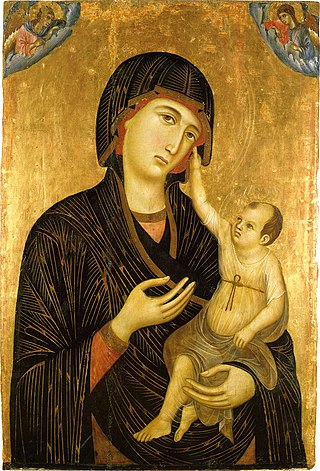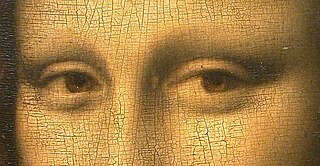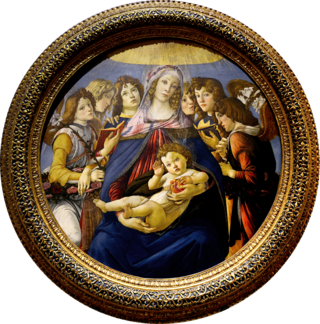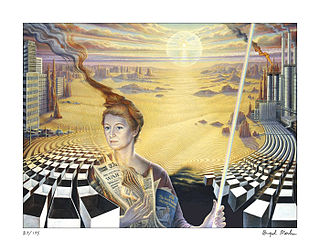
Acrylic paint is a fast-drying paint made of pigment suspended in acrylic polymer emulsion and plasticizers, silicone oils, defoamers, stabilizers, or metal soaps. Most acrylic paints are water-based, but become water-resistant when dry. Depending on how much the paint is diluted with water, or modified with acrylic gels, mediums, or pastes, the finished acrylic painting can resemble a watercolor, a gouache, or an oil painting, or have its own unique characteristics not attainable with other media.

A mural is any piece of graphic artwork that is painted or applied directly to a wall, ceiling or other permanent substrate. Mural techniques include fresco, mosaic, graffiti and marouflage.

Oil painting is the process of painting with pigments with a medium of drying oil as the binder. It has been the most common technique for artistic painting on canvas, wood panel or copper for several centuries, spreading from Europe to the rest of the world. The advantages of oil for painting images include "greater flexibility, richer and denser colour, the use of layers, and a wider range from light to dark". But the process is slower, especially when one layer of paint needs to be allowed to dry before another is applied.

Paint is a liquid pigment that, after applied to a solid material and allowed to dry, adds a film-like layer, in most cases to create an image, known as a painting. Paint can be made in many colors and types. Most paints are either oil-based or water-based, and each has distinct characteristics.

Tempera, also known as egg tempera, is a permanent, fast-drying painting medium consisting of pigments mixed with a water-soluble binder medium, usually glutinous material such as egg yolk. Tempera also refers to the paintings done in this medium. Tempera paintings are very long-lasting, and examples from the first century AD still exist. Egg tempera was a primary method of painting until after 1500 when it was superseded by oil painting. A paint consisting of pigment and binder commonly used in the United States as poster paint is also often referred to as "tempera paint", although the binders in this paint are different from traditional tempera paint.

Gesso, also known "glue gesso" or "Italian gesso", is a white paint mixture used to coat rigid surfaces such as wooden painting panels or masonite as a permanent absorbent primer substrate for painting. It consists of a binder mixed with chalk, gypsum, pigment, or any combination of these.

Gouache, body color, or opaque watercolor is a water-medium paint consisting of natural pigment, water, a binding agent, and sometimes additional inert material. Gouache is designed to be opaque. Gouache has a long history, having been used for at least twelve centuries. It is used most consistently by commercial artists for posters, illustrations, comics, and other design work.

Oil paint is a type of slow-drying paint that consists of particles of pigment suspended in a drying oil, commonly linseed oil. The viscosity of the paint may be modified by the addition of a solvent such as turpentine or white spirit, and varnish may be added to increase the glossiness of the dried oil paint film. The addition of oil or alkyd medium can also be used to modify the viscosity and drying time of oil paint. Oil paints were first used in Asia as early as the 7th century AD and can be seen in examples of Buddhist paintings in Afghanistan. Oil-based paints made their way to Europe by the 12th century and were used for simple decoration, but oil painting did not begin to be adopted as an artistic medium there until the early 15th century. Common modern applications of oil paint are in finishing and protection of wood in buildings and exposed metal structures such as ships and bridges. Its hard-wearing properties and luminous colors make it desirable for both interior and exterior use on wood and metal. Due to its slow-drying properties, it has recently been used in paint-on-glass animation. The thickness of the coat has considerable bearing on the time required for drying: thin coats of oil paint dry relatively quickly.

Craquelure is a fine pattern of dense cracking formed on the surface of materials. It can be a result of drying, shock, aging, intentional patterning, or a combination of all four. The term is most often used to refer to tempera or oil paintings, but it can also develop in old ivory carvings or painted miniatures on an ivory backing. Recently, analysis of craquelure has been proposed as a way to authenticate art.

The Madonna of the Pomegranate was painted in circa 1487 with tempera on a wood panel by Sandro Botticelli. It is now in the Uffizi in Florence. Sandro Botticelli was a leading Italian Renaissance artist from Florence, Italy. The Madonna (art) uses the circular format, better known as a tondo, which focuses the attention on the main characters, the Virgin Mary and baby Jesus, who are surrounded symmetrically by angels on each side. Botticelli's use of tempera grassa give the characters a real look, better known as a "naturalistic" style, which is common during the Renaissance. The Virgin Mary is holding baby Jesus gently in her arms while holding a pomegranate in her left hand.
A glaze is a thin transparent or semi-transparent layer on a painting which modifies the appearance of the underlying paint layer. Glazes can change the chroma, value, hue and texture of a surface. Glazes consist of a great amount of binding medium in relation to a very small amount of pigment. Drying time will depend on the amount and type of paint medium used in the glaze. The medium, base, or vehicle is the mixture to which the dry pigment is added. Different media can increase or decrease the rate at which oil paints dry.

Brigid Marlin is an American artist based in Hertfordshire, UK. She studied in Dublin, Montreal, New York, Paris and Vienna where, under the guidance of the Austrian artist Ernst Fuchs, she learned the oil and egg tempera technique (Mischtechnik) of the Flemish and Italian Renaissance painters Jan van Eyck and Giovanni Bellini. In 1961 she founded the ins-cape group, which subsequently became the Society for Art of Imagination.
Working in layers is a system for creating artistic paintings that involve the use of more than one layer of paint.

A wash is a term for a visual arts technique resulting in a semi-transparent layer of colour. A wash of diluted ink or watercolor paint applied in combination with drawing is called pen and wash, wash drawing, or ink and wash. Normally only one or two colours of wash are used; if more colours are used the result is likely to be classified as a full watercolor painting.

Robert Venosa was an American Fantastic Realistic, Visionary painter who resided in Cadaques, Spain and Boulder, Colorado, US. He studied with what are termed the New Masters. His artworks reside in collections around the world.
Acrylic painting techniques are different styles of manipulating and working with polymer-based acrylic paints. Acrylics differ from oil paints in that they have shorter drying times and are soluble in water. These types of paint eliminate the need for turpentine and gesso, and can be applied directly onto canvas. Aside from painting with concentrated color paints, acrylics can also be watered down to a consistency that can be poured or used for glazes.

Painting is the practice of applying paint, pigment, color or other medium to a solid surface. The medium is commonly applied to the base with a brush, but other implements, such as knives, sponges, and airbrushes, can be used.

Work on the conservation and restoration of Leonardo da Vinci's The Last Supper mural, much of it more harmful than helpful, has been carried out over many centuries, and continues. Completed in the late 15th century by the Renaissance artist Leonardo da Vinci, the mural is located in the refectory of the Convent of Santa Maria delle Grazie, Milan, Italy. The Last Supper was commissioned by Ludovico Sforza, Duke of Milan in 1495, as part of a series of renovations to the convent with the intention that the location would become the Sforza family mausoleum. Painting began in 1495 and continued until 1498.

The conservation and restoration of paintings is carried out by professional painting conservators. Paintings cover a wide range of various mediums, materials, and their supports. Painting types include fine art to decorative and functional objects spanning from acrylics, frescoes, and oil paint on various surfaces, egg tempera on panels and canvas, lacquer painting, water color and more. Knowing the materials of any given painting and its support allows for the proper restoration and conservation practices. All components of a painting will react to its environment differently, and impact the artwork as a whole. These material components along with collections care will determine the longevity of a painting. The first steps to conservation and restoration is preventive conservation followed by active restoration with the artist's intent in mind.
The conservation-restoration of panel paintings involves preventive and treatment measures taken by paintings conservators to slow deterioration, preserve, and repair damage. Panel paintings consist of a wood support, a ground, and an image layer. They are typically constructed of two or more panels joined together by crossbeam braces which can separate due to age and material instability caused by fluctuations in relative humidity and temperature. These factors compromise structural integrity and can lead to warping and paint flaking. Because wood is particularly susceptible to pest damage, an IPM plan and regulation of the conditions in storage and display are essential. Past treatments that have fallen out of favor because they can cause permanent damage include transfer of the painting onto a new support, planing, and heavy cradling. Today's conservators often have to remediate damage from previous restoration efforts. Modern conservation-restoration techniques favor minimal intervention that accommodates wood's natural tendency to react to environmental changes. Treatments may include applying flexible battens to minimize deformation or simply leaving distortions alone, instead focusing on preventive care to preserve the artwork in its original state.














